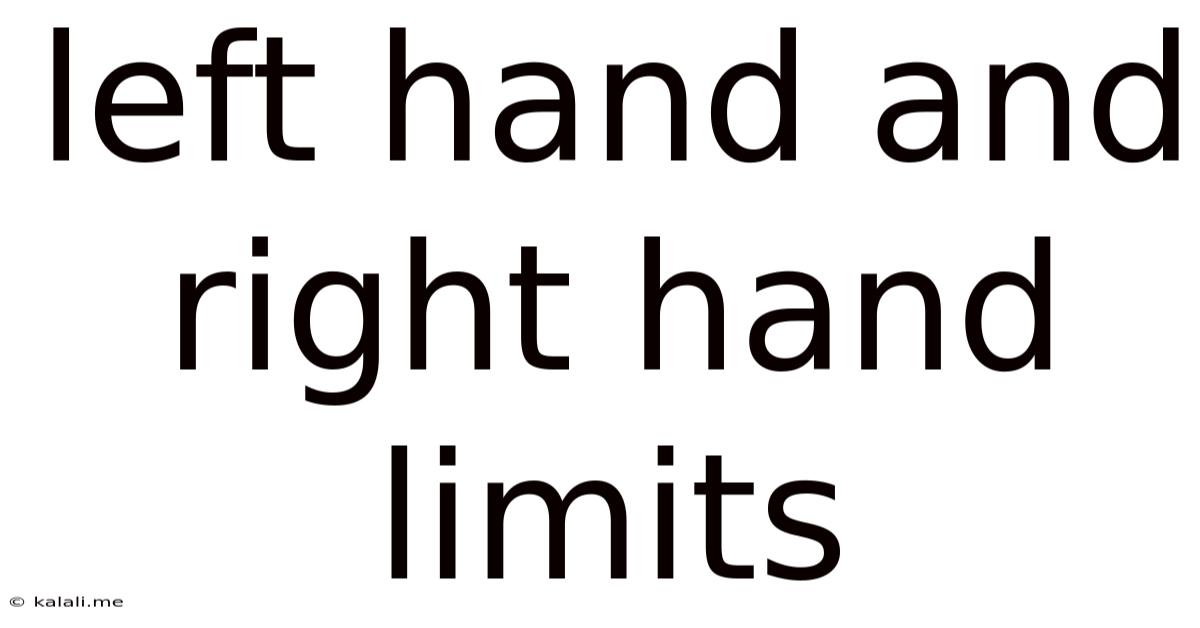Left Hand And Right Hand Limits
Kalali
Jun 11, 2025 · 4 min read

Table of Contents
Understanding Left-Hand and Right-Hand Limits: A Comprehensive Guide
Meta Description: Learn about left-hand and right-hand limits, crucial concepts in calculus. This guide explains their definitions, how to calculate them, and provides examples to solidify your understanding. Master these concepts for a deeper grasp of limits and continuity.
Limits are a fundamental concept in calculus, forming the basis for understanding derivatives and integrals. While the concept of a general limit describes the behavior of a function as its input approaches a specific value, it's crucial to understand the nuances of left-hand limits and right-hand limits. These concepts are vital for determining whether a limit exists and for analyzing the continuity of a function.
What are Left-Hand and Right-Hand Limits?
The limit of a function at a point c exists if and only if the function approaches the same value from both the left and the right of c. Let's break down what this means:
-
Left-Hand Limit: This refers to the value the function approaches as x approaches c from values less than c. We denote this as:
lim<sub>x→c<sup>-</sup></sub> f(x)
-
Right-Hand Limit: This refers to the value the function approaches as x approaches c from values greater than c. We denote this as:
lim<sub>x→c<sup>+</sup></sub> f(x)
A limit exists at c only if the left-hand limit and the right-hand limit are equal:
lim<sub>x→c<sup>-</sup></sub> f(x) = lim<sub>x→c<sup>+</sup></sub> f(x) = L (where L is the limit)
Calculating Left-Hand and Right-Hand Limits
Calculating these limits often involves direct substitution, but sometimes requires techniques like factoring, rationalizing, or using L'Hôpital's rule (for indeterminate forms). Let's explore some examples:
Example 1: A Simple Function
Let's consider the function f(x) = x + 2. Let's find the left-hand and right-hand limits as x approaches 3.
- Left-hand limit: lim<sub>x→3<sup>-</sup></sub> (x + 2) = 3 + 2 = 5
- Right-hand limit: lim<sub>x→3<sup>+</sup></sub> (x + 2) = 3 + 2 = 5
Since both limits are equal to 5, the limit lim<sub>x→3</sub> (x + 2) = 5 exists.
Example 2: A Piecewise Function
Piecewise functions are excellent for illustrating the importance of left-hand and right-hand limits. Consider:
f(x) = { x + 1, if x < 2 { x<sup>2</sup> - 2, if x ≥ 2
Let's examine the behavior around x = 2:
- Left-hand limit: lim<sub>x→2<sup>-</sup></sub> f(x) = lim<sub>x→2<sup>-</sup></sub> (x + 1) = 3
- Right-hand limit: lim<sub>x→2<sup>+</sup></sub> f(x) = lim<sub>x→2<sup>+</sup></sub> (x<sup>2</sup> - 2) = 2
Since the left-hand limit (3) and the right-hand limit (2) are not equal, the limit lim<sub>x→2</sub> f(x) does not exist.
Example 3: A Function with a Removable Discontinuity
Consider the function:
f(x) = (x<sup>2</sup> - 4) / (x - 2)
Notice that the function is undefined at x = 2. However, we can simplify:
f(x) = (x - 2)(x + 2) / (x - 2) = x + 2, for x ≠ 2
Now let's find the limits:
- Left-hand limit: lim<sub>x→2<sup>-</sup></sub> (x + 2) = 4
- Right-hand limit: lim<sub>x→2<sup>+</sup></sub> (x + 2) = 4
Even though the function is undefined at x = 2, the limit exists and is equal to 4. This is a removable discontinuity.
Importance of Left-Hand and Right-Hand Limits
Understanding left-hand and right-hand limits is essential for:
- Determining if a limit exists: As shown in the examples, the existence of a limit depends on the equality of the left-hand and right-hand limits.
- Analyzing continuity: A function is continuous at a point if the limit exists at that point, the function is defined at that point, and the limit equals the function's value at that point.
- Understanding derivatives: The derivative of a function at a point is defined using limits, and the existence of the derivative often relies on the existence and equality of left-hand and right-hand derivatives (which are themselves based on left-hand and right-hand limits).
By mastering the concepts of left-hand and right-hand limits, you’ll gain a more profound understanding of calculus and its applications. Practice with various functions, including piecewise functions and functions with discontinuities, to reinforce your understanding.
Latest Posts
Latest Posts
-
How Much Does 2 Liters Of Water Weigh
Jul 01, 2025
-
If I Was Born In 1985 How Old Am I
Jul 01, 2025
-
How Many Quarters Are In An Ounce
Jul 01, 2025
-
How Many Times Does 11 Go Into 40
Jul 01, 2025
-
Elvis Presley Gospel One Pair Of Hands
Jul 01, 2025
Related Post
Thank you for visiting our website which covers about Left Hand And Right Hand Limits . We hope the information provided has been useful to you. Feel free to contact us if you have any questions or need further assistance. See you next time and don't miss to bookmark.